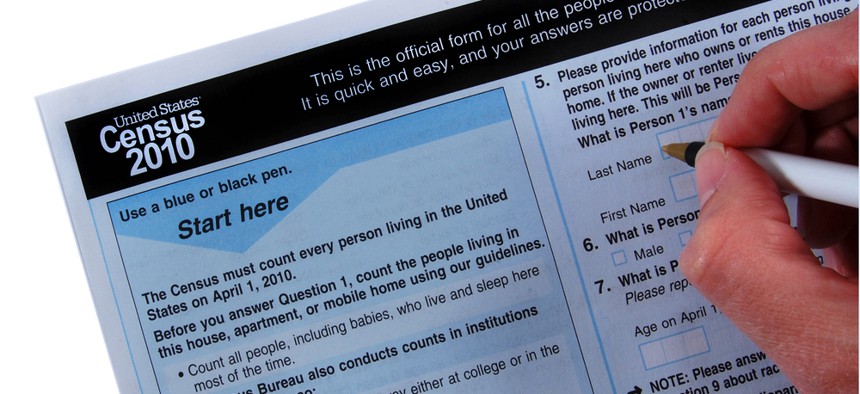sponsor content What's this?
Countdown to 2020: The Population Clock and Making Digital Count

Presented by
Adobe

The Census Bureau's digital redesign has made accessing data easier than ever.
On the new Census.gov website, a population clock tallies the number of people living in the United States by the second. Another site page provides accessible information about people, businesses and geography, broken down by state. And for a quick summary on economic indicators, the U.S. Census Bureau’s Economic Indicators widget provides data on everything from construction spending to rental vacancy rates.
These tools are part of a broader digital transformation being undertaken by the agency, which is tasked with collecting and disseminating information about the American population and economy.
Now in preparation for 2020, and the next census, the agency is embarking on a mission to align their digital offerings with the needs of their public.
“Census realized that they needed to move to a more modern platform that is accessible,” says Jake Brody, managing director of the Census Bureau program at Accenture Federal Services. “Their main goal is making Census.gov a customer-centric destination that serves as the first stop for economic, demographic, and geographic data”. Key to this was a complete redesign of the Census Bureau’s website, Census.gov, which receives more than 40 million visits a year and averages over 500,000 page views a day.
“The Census site is essentially their front door,” Brody says, highlighting the importance of the site as an avenue for the distribution of census information.
By modernizing their digital offerings and reimagining their website, the agency realized it would be better equipped to provide the public with the data that they need.
“The first efforts were to align our information with the needs of users,” says Raul Cisneros, director of the Center for New Media and Promotion at the Census Bureau. “So that process started with research: What does the research tell us? What do our customers want? What are the challenges? We wanted to get that foundation to help guide us in our decisions.”
From this initial research, the Census Bureau was able to identify key areas of improvement. They implemented a new content management system (CMS), migrated high-value content into the CMS and made significant improvements to search and navigation capabilities — two areas that research indicated users found difficult to use.
Since the Census Bureau has hundreds of thousands of assets ranging from HTML pages to documents, videos and datasets, it’s no surprise that search and navigation are essential for the agency.
“We have a topic-based navigation now that we’ve implemented, and then we looked at how we can enhance search, and we’ve made some terrific improvements,” Cisneros says. “We have answers before results.”
This means it’s easier than ever for site visitor to find the information that they need. A high-level navigation bar at the top of the screen breaks down the site into thematic chunks: population, economy, geographic data, datasets and a content library of publications. And the search tool has been redesigned to provide ‘Answers’ to the most popular queries on the Census site.
According to Brody, these changes caused the satisfaction related to search to improve 11 points from the original baseline (a number determined using the ForeSee E-Government Satisfaction Index). Since satisfaction with search and navigation are so closely linked with user experience, improving these functions helped raise overall customer satisfaction of the website from a score of 58 to a recent high of 69, placing Census.gov near the standard for government websites.
To continually improve their digital presence, the Census Bureau has implemented rigorous site analytics that allow them to track how users are engaging with the site. This gives them a sense for what’s working and what needs to be refined to provide better usability, something that’s especially critical given the constantly evolving nature of digital.
“I alluded to the fact we did our research. That’s something we continue to do,” Cisneros says. “It’s important, again, that we want to make the decisions based on what the analytics are telling us.”
This transformation in usability was powered in part by the Census Bureau’s back-end migration of their site to Adobe Experience Manager (AEM), a content management system that allows the Bureau to create, manage and optimize digital content across all channels and platforms. By combining AEM with Adobe Analytics, a digital analytics tool, the Census Bureau is able to gain unprecedented accessibility and visibility in terms of user behavior.
“We’re setting the pace, if you will, for how to provide an experience to users,” Cisneros says. “With so much content, it’s just so vital for us to put that in the content management system so that we’re only making changes once, and just to provide order to the website, particularly since we have so many assets.”
The Census Bureau’s digital transformation is underway and a definite success, as evidenced by a 118 percent year-over-year increase in engagement with the agency’s transformed content. But it’s by no means complete. In the years to come, the Bureau plans on making their site completely responsive, since currently almost 23 percent of their site traffic comes from mobile devices. They also plan on incorporating customer feedback into future plans for their digital offerings, as they go about developing new applications and further enhancing search capabilities for the 2020 U.S. Census.
“I would tell those that want to embark on changing the website: Do your research,” Cisneros says. “What are your customers telling you? Because public entities are here to serve the public.”
Read more about how government is creating unique and engaging digital experiences for citizens.
This article was produced on behalf of Adobe by GEMG Custom Strategies, the marketing services division of Government Executive Media Group. The editorial staff of Nextgov was not involved in its preparation.
NEXT STORY: Putting an End to the Paper Trail


